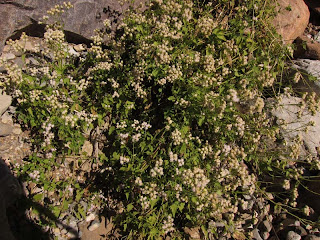This past Saturday I did a short botanizing/birding/bugging hike up French Joe Canyon east of Tucson with my friend Greg Corman. Greg, owner of Gardening Insights is a botanist, landscape designer and artist who has been with me to Bolivia a couple times on our “birds & botany” tours. We could have spent all day in a just 100 meters of the canyon, but I was itching to get the "upper spring."
French Joe is a special place. Just south of Kartchner
Cavers State Park, it drains eastward out of the Whetstone Mountains, a largely
limestone uplifted range. It became famous among birders in 1995 when John
Martin found a singing, territorial Rufous-capped Warbler in the upper part of
the canyon, a good mile hike after a very rough entry in a high-clearance
vehicle. That same year a second territorial bird was found, and then in
subsequent years a lone male continued, and then after a couple years was then joined by a female, and they bred for a
few years until the upper spring dried up in the early oughts.
On the rough drive in, I yelled for Greg to stop for a
lizard – and I was able to sneak up and get a closeup of this juvenile Eastern
Collared Lizard.
We stopped just before the end of the road, as the last 100
meters or so passes through a lovely woodland, the Western Soapberry thickets
adding some authentic fall color.
The slope, exposure, drainage, and geology all conspire to
make this a very interesting place botanically, reflected very closely in the
invertebrate life as well. In the understory of the lower copse is a healthy
patch of Arizona Orange, Choisya dumosa var.
arizonica, a member of the rue family
(same as citrus).
The variety of composites (plants in the family Asteraceae)
had me on my toes. I keyed out seven, using the only key that has all the
species: the dreaded Kearney & Peebles. The first one I tackled had me in a
tizzy, as it just wouldn’t key out. It turns out there is a fatal error in the
already atrocious dichotomous key in this ancient, utterly illustration-free tome (1960). If you happen to
have a Coreocarpus without any pappus on the achene, you’re out of luck; that genus does not appear
in the key for Asteraceae with ray flowers and no pappus. But I persevered, tried
other keys, and arrived at: Little Lemonhead, Coreocarpus arizonicus var. arizonicus.
This one is populated by the pretty little buprestid beetle Acmaeodera
amabilis.
The rest:
Gumhead, Gymnosperma
glutinosum
Harweg's Pricklyleaf, Thymophylla
pentachaeta var. hartwegii
Lavender Thoroughwort, Fleischmannia
pycnocephala
Thurber's Sneezeweed, Helenium thurberi
Long-stalked Greenhead, Thelesperma
longipes
Wright's Thimblehead, Hymenothryx
wrightii
I do key out other plants from time to time. This is Ipomoea cristulata, Transpecos
Morningglory, this individual notable for having sprouted, put out one pair of true leaves above the cotyledons, and bloomed. Hurry!
Broom Milkwort, Polygala
scoparioides from the odd family Polygalaceae. I once tried to key one out
in the pea family and nearly killed myself (and everyone else in the room). Then I figured maybe it wasn't a pea.
I had no idea we had another ceanthous here in SE Arizona. Desert
Ceanothus, Ceanothus greggii var. perplexans
For a brief dip into Animalia, we saw a few Arizona
Giant-Skippers, Agathymus aryxna
Jim Brock informs me that this is Poling's Giant-Skipper, Agathymus polingi, after all. That's the one I had been hoping to see!
Jim Brock informs me that this is Poling's Giant-Skipper, Agathymus polingi, after all. That's the one I had been hoping to see!
I recognized this caterpillar as one of the dull hooded
owlet moths. It looks a lot like an eastern species (Cucullia convexipennis), but the wizards at
bugguide.net haven’t chimed in yet: Cucullia
sp. Lovely in any event. Stay current with my buggguide post here.
Oh, I almost completely forgot: once we got to the upper
spring, where bird activity was very quiet, we found that there was some
surface water in one pool where 10 years ago there had been a trickling stream. Better than nothing (the rest of the canyon was dry, save for one pool in the lower woodland). So I pished and imitated Western Screech-Owl, hoping to
attract something more than the 2 or 3 Chipping Sparrows that had come in for a drink.
In came more Chipping Sparrows, a Bridled Titmouse, a pair of Bewick’s Wrens, a couple Ruby-crowned Kinglets, a
Hermit Thrush in the undergrowth (they love the sumac berries in abundance
here), and then on top of a bush over the pool a yellow-breasted bird. I
didn’t even lift my binoculars and got Greg to look – a Rufous-capped Warbler!
There hadn’t been one reported from here since August 2008, and before that,
May 2004. Has there been one in residence ever since John’s discovery in 1995?
The Rufous-cap came in quietly, briefly appeared wren-like in the middle of the
bushes only 4 feet in front of us, and moved on. What a thrill.





















I may hike there tomorrow, but I heard there is a cave up French Joe Canyon. I've been to the top of Cottonwood Peak and I want to hike to the top of Apache Peak but hikers are rare in the Benson-Pomerene area. I'm interested in wild caves in the Whetstone Mountains. The ones in rugged terrain you have to get off trail to get to
ReplyDelete